Ok, part 3, after im done with this ill be 1/3rd through the test. Exciting. Not much eles for an intro.
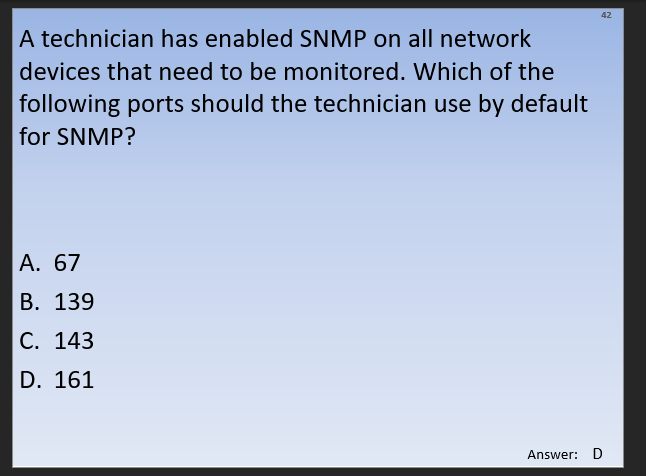
Most of todays review is not super complicated. Its just memorizing stuff. Like this.
- Simple Network Management Protocol is an Internet Standard protocol for collecting and organizing information about managed devices on IP networks and for modifying that information to change device behavior. Wikipedia
- Port(s): 161, 162 (Trap)
Honestly didnt even know what SNMP was.
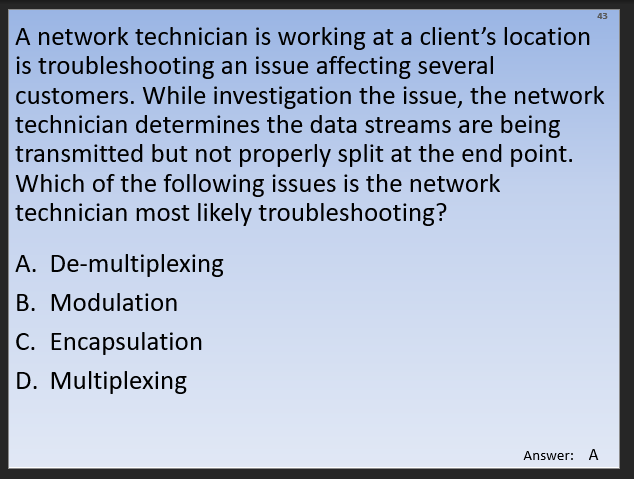
To be honest with you, I dont really know what any of this is. Lets find out though.
- Multiplexing – Multiplexing is a popular networking technique that integrates multiple analog and digital signals into a signal transmitted over a shared medium. Multiplexers and de-multiplexers are used to convert multiple signals into one signal. This term is also known as muxing.
- de-multiplexing – A demultiplexer (or demux) is a device that takes a single input line and routes it to one of several digital output lines. A demultiplexer of 2n outputs has n select lines, which are used to select which output line to send the input
- encapsolation – In computer networking, encapsulation is a method of designing modular communication protocols in which logically separate functions in the network are abstracted from their underlying structures by inclusion or information hiding within higher level objects.
- modulation-In electronics and telecommunications, modulation is the process of varying one or more properties of a periodic waveform, called the carrier signal, with a modulating signal that typically contains information to be transmitted
Ah yes, of course. The ye old ‘how far down the rabbit hole would like to go.’ For now, far enough to get this cert and now that I know the answers, its clearly A.
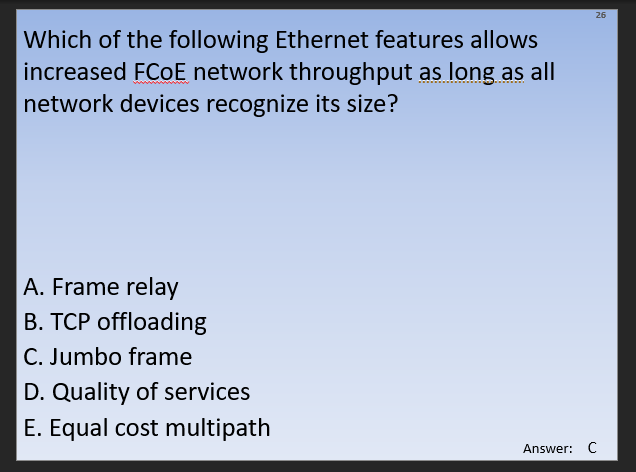
Yeah, i dont know. I’m going to make a list of things I dont know about.
- FCoE – Fibre Channel over Ethernet (FCoE) is a computer network technology that encapsulates Fibre Channel frames over Ethernet networks. This allows Fibre Channel to use 10 Gigabit Ethernet networks (or higher speeds) while preserving the Fibre Channel protocol.
- Frame Relay – Frame relay is a packet-switching telecommunication service designed for cost-efficient data transmission for intermittent traffic between local area networks (LANs) and between endpoints in wide area networks (WANs).
- TCP Offloading -TCP offload engine is a function used in network interface cards (NIC) to offload processing of the entire TCP/IP stack to the network controller. By moving some or all of the processing to dedicated hardware, a TCP offload engine frees the system’s main CPU for other tasks.
- Jumbo Frame – A jumbo frame is an Ethernet frame with a payload greater than the standard maximum transmission unit (MTU) of 1,500 bytes. Jumbo frames are used on local area networks that support at least 1 Gbps and can be as large as 9,000 bytes. Because jumbo frames are not defined in the IEEE 802.3 specifications for Ethernet, vendor support for jumbo frames and their maximum transmission units may vary.
- Quality of Services – Quality of service (QoS) refers to any technology that manages data traffic to reduce packet loss, latency and jitter on the network. QoS controls and manages network resources by setting priorities for specific types of data on the network.
- Equal cost multipath – a network routing strategy that allows for traffic of the same session, or flow—that is, traffic with the same source and destination—to be transmitted across multiple paths of equal cost. … When forwarding a packet, the routing technology must decide which next-hop path to use.
You know, im starting to see this theme where when you understand what the answers are, the correct one is apparent. Its just this test though. Dont worry.
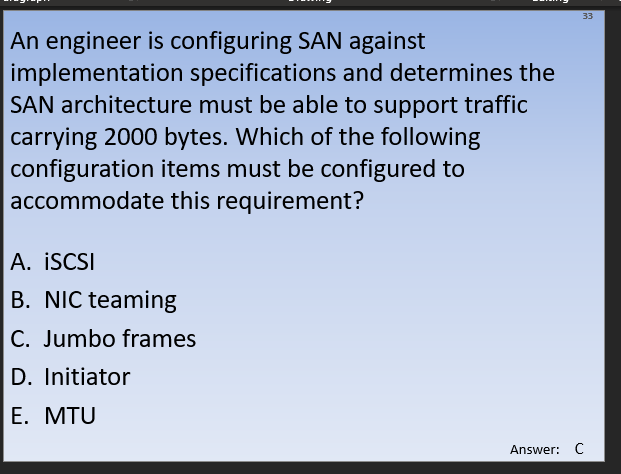
Interesting, I set this one out to learn as well and it turns out. Its the same answer and it was apparent right away once I put effort into understanding what was going on.
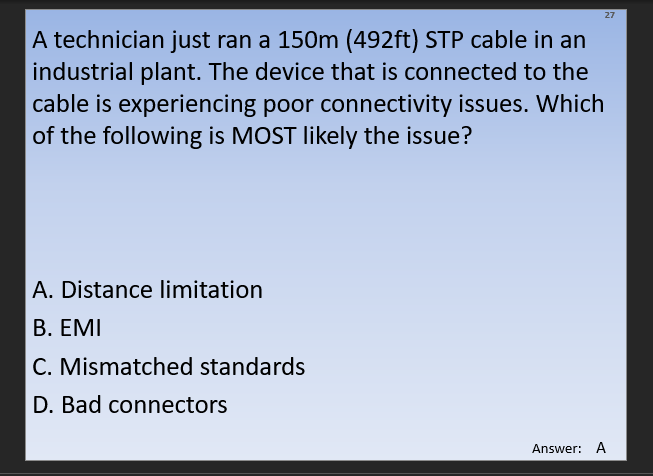
I’m not putting a ton of effort into this as there isnt a ton of effort put into describing the material the cable was made of which would give the indicator for a need for a singal repeater. Wait whats that, it does? Lets look that up because that would be the answer. The maximum length is 100 meters, without using any kind of signal regeneration device, and a maximum data transfer rate of 1000 Mbps for Gigabit Ethernet. Shielded Twisted Pair (STP), like UTP, also has four pairs of wires with each wire in each pair twisted together.. Well, there we go, cable is about 50% too long.
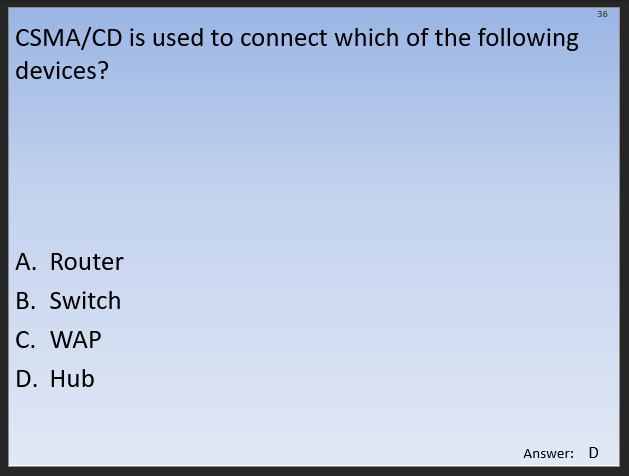
No idea what this is, lets find out!
Carrier-sense multiple access with collision detection (CSMA/CD) is a media access control method used most notably in early Ethernet technology for local area networking. It uses carrier-sensing to defer transmissions until no other stations are transmitting.
So this is some old lan stuff and hub is the only thing that makes any sense.
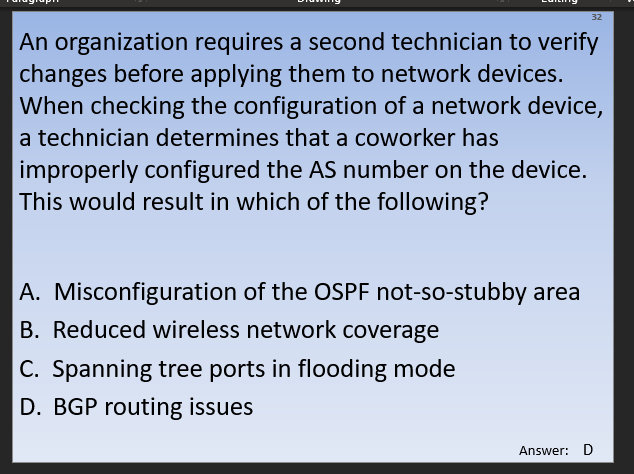
Its list time again, boys and girls.
- AS number – An autonomous system number (ASN) is a unique number that’s available globally to identify an autonomous system and which enables that system to exchange exterior routing information with other neighboring autonomous systems. The number of autonomous system numbers is limited.
- OSFP – Octal Small Formfactor Pluggable, is a very new module and interconnect system in development that is targeted to support 400-G optical data links inside datacenters, campuses and external metro long reach.
- Tree ports in flooding mode – a unicast flood is when a switch receives a unicast frame and treats it as a broadcast frame, flooding the frame to all other ports on the switch.
- BGP routing issues – Border Gateway Protocol is protocol that manages how packets are routed across the internet through the exchange of routing and reachability information between edge routers. BGP directs packets between autonomous systems (AS) — networks managed by a single enterprise or service provider
So this one isn’t exactly clear to me at this point but i can vaguely get the concept.

Leave a comment